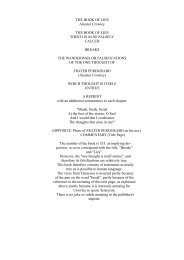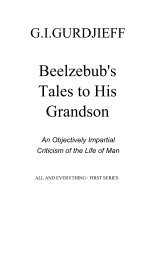Richard Rose’s Psychology of the Observer The Path to Reality Through the Self
John-Kent-Richard-Rose's-Psychology-of-Observer-Path-to-Reality-Thru-the-Self
John-Kent-Richard-Rose's-Psychology-of-Observer-Path-to-Reality-Thru-the-Self
Create successful ePaper yourself
Turn your PDF publications into a flip-book with our unique Google optimized e-Paper software.
Reconcilia<strong>to</strong>ry Points 329<br />
identity gradually shift from <strong>the</strong> former <strong>to</strong> <strong>the</strong> latter as its source, as categorized more specifically in<br />
<strong>the</strong> four phases mentioned earlier.<br />
This is much like a rocket going from <strong>the</strong> Earth <strong>to</strong> <strong>the</strong> Moon. At first, it is difficult for <strong>the</strong> rocket<br />
<strong>to</strong> escape <strong>the</strong> Earth’s gravity field, <strong>the</strong> same as it is for <strong>the</strong> ego-mind <strong>to</strong> become disassociated from<br />
strictly mundane attachments. Gradually, it reaches <strong>the</strong> mid-point between <strong>the</strong> gravity fields <strong>of</strong> <strong>the</strong><br />
two bodies <strong>of</strong> influence. This is <strong>the</strong> stretch <strong>of</strong> <strong>the</strong> path where <strong>the</strong> seeker really does not have a home,<br />
ei<strong>the</strong>r in <strong>the</strong> world or in Heaven. This is <strong>the</strong> transition between phases two and three listed above,<br />
and where <strong>the</strong> committed vec<strong>to</strong>r is all one has—or is. By this point, one no longer regards awareness<br />
as “my” awareness (like <strong>the</strong> egocentrically designated borders <strong>of</strong> a country’s air space), but as impersonal,<br />
boundless awareness (like <strong>the</strong> atmosphere <strong>of</strong> <strong>the</strong> Earth). <strong>The</strong>re is no “picture-frame” delineating<br />
<strong>the</strong> boundaries <strong>of</strong> aware selfhood. From here on, one begins <strong>to</strong> identify more and more with <strong>the</strong><br />
<strong>Observer</strong> than with <strong>the</strong> observed (including <strong>the</strong> person-as-self), as <strong>the</strong> gravity <strong>of</strong> <strong>the</strong> higher Mind<br />
pulls one back in<strong>to</strong> it, reversing <strong>the</strong> Fall.<br />
<strong>The</strong> advantage <strong>of</strong> <strong>Rose’s</strong> method <strong>of</strong> teaching is that he does not allow room for <strong>the</strong> seeker <strong>to</strong><br />
cheat by pretending in imagination that one is really “<strong>the</strong> <strong>Self</strong>”, and thus rationalize sitting idly in<br />
ignorance, when this “Moon landing” has not yet been accomplished in experience. He is advocating<br />
that work be done on both “I’s” at once, until <strong>the</strong> All is attained and <strong>the</strong>re is no longer any division.<br />
Advaita tends <strong>to</strong> emphasize only <strong>the</strong> <strong>to</strong>p end <strong>of</strong> this channel between <strong>the</strong> aware <strong>Self</strong> and <strong>the</strong><br />
human self, with little attention paid <strong>to</strong> <strong>the</strong> consequential follow-through from <strong>the</strong> bot<strong>to</strong>m or relative<br />
end. Zen works from both ends at <strong>the</strong> same time: <strong>the</strong> mind’s making <strong>the</strong> effort <strong>to</strong> answer <strong>the</strong> mind<br />
and cultivating <strong>the</strong> detached comprehension <strong>of</strong> this dualistic effort, until <strong>the</strong> channel is cleared through<br />
and pure awareness permeates all in unity. This comparison also somewhat parallels <strong>the</strong> relationship<br />
between Raja and Jnana yogas. Raja can be likened <strong>to</strong> Advaita in its emphasis upon <strong>the</strong> direct<br />
approach <strong>to</strong> realization <strong>of</strong> transcendental Being. Jnana involves Zen’s attending <strong>to</strong> <strong>the</strong> discernment<br />
between <strong>the</strong> real and <strong>the</strong> unreal and <strong>the</strong>reby backing in<strong>to</strong> a truer quality <strong>of</strong> mind. Thus <strong>the</strong> latter<br />
(Jnana/Zen) can be considered <strong>to</strong> be a part <strong>of</strong> <strong>the</strong> methodology <strong>to</strong> implement <strong>the</strong> aim <strong>of</strong> <strong>the</strong> former<br />
(Raja/Advaita).<br />
Fur<strong>the</strong>rmore, <strong>to</strong> tie some o<strong>the</strong>r previously discussed <strong>the</strong>mes <strong>to</strong>ge<strong>the</strong>r, <strong>the</strong> ideal <strong>of</strong> Raja yoga<br />
can be realized through ei<strong>the</strong>r <strong>of</strong> its two forms or routes: <strong>the</strong> path <strong>of</strong> mindfulness (which is <strong>of</strong> <strong>the</strong><br />
masculine nature) and <strong>the</strong> path <strong>of</strong> devotion (<strong>the</strong> feminine nature). When properly manifested, both<br />
are non-dualistic. However, one must be very young or very old inside <strong>to</strong> take ei<strong>the</strong>r road effectively:<br />
young enough <strong>to</strong> not yet have a ponderous ego <strong>of</strong> resistance or old enough that it is dead or dying. In<br />
addition, despite <strong>the</strong> critical comments in <strong>the</strong> introduc<strong>to</strong>ry section <strong>of</strong> this report about <strong>the</strong> path <strong>of</strong><br />
devotion contrasted with <strong>the</strong> path <strong>of</strong> mindfulness, in mature experience <strong>the</strong>se become more <strong>the</strong> same<br />
<strong>the</strong> more we become whole.<br />
<strong>The</strong> Fourth Way seeker works both ends <strong>of</strong> <strong>the</strong> channel at once by employing <strong>the</strong> Heart’s way<br />
<strong>to</strong> wholeness through function and Mind’s way <strong>to</strong> wholeness through comprehension simultaneously.<br />
In practice, honest devotion is <strong>the</strong> underside <strong>of</strong> being. Doubting inquiry is <strong>the</strong> underside <strong>of</strong> awareness.<br />
Toge<strong>the</strong>r <strong>the</strong>y are <strong>the</strong> prayer <strong>of</strong> <strong>the</strong> soul, which is <strong>the</strong> channel. Whe<strong>the</strong>r <strong>the</strong> core <strong>of</strong> one’s path is<br />
<strong>to</strong> reside wholly in <strong>the</strong> Witness or <strong>to</strong> genuinely surrender <strong>to</strong> God (meaning: “what is”), <strong>the</strong> result is<br />
<strong>the</strong> same: becoming <strong>the</strong> Truth. Ei<strong>the</strong>r way, <strong>the</strong> mental construct that regards itself as a seeker who is<br />
doing <strong>the</strong> witnessing or <strong>the</strong> surrendering is at last dissolved and reabsorbed in<strong>to</strong> <strong>the</strong> <strong>Self</strong>. This is also<br />
where <strong>the</strong> comments in <strong>the</strong> section on sexuality and transmutation reach <strong>the</strong>ir fruition. Love is not<br />
sentiment or sensuality. Love is <strong>the</strong> feeling <strong>of</strong> being; <strong>the</strong> awareness <strong>of</strong> unity.<br />
Taking all this in<strong>to</strong> account, <strong>Rose’s</strong> use <strong>of</strong> Zen in <strong>the</strong> Albigen System could be said <strong>to</strong> incorporate<br />
<strong>the</strong> purest meaning <strong>of</strong> Advaita—abiding in <strong>the</strong> stillness <strong>of</strong> <strong>the</strong> aware <strong>Self</strong> that contains all experi-




